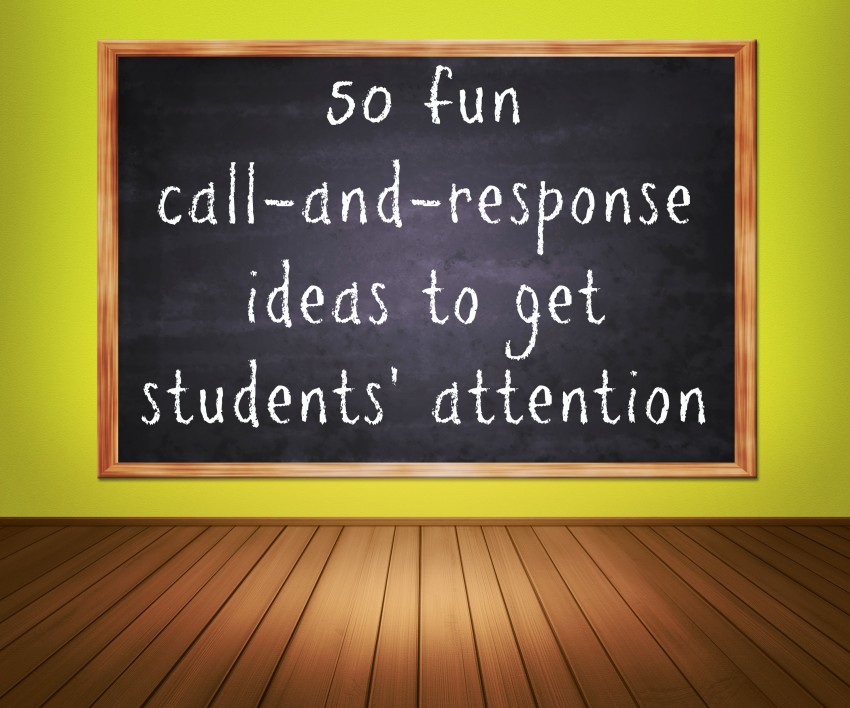Have you fallen into the trap of saying “No talking!” or “I need quiet!” all day long?
It’s exhausting to keep repeating your requests for silence, and after the hundredth time, kids just tune you out, anyway. There have been some great discussions about how to get students to quiet down on my Facebook page, and I want to share what’s worked for those teachers as well as what I’ve tried in my own classroom. Contributors’ names are written in parentheses where applicable.

1. Sing a song.
For the youngest students, use finger plays like the Itsy Bitsy Spider and Open, Shut Them. Students of any age will respond to simple tunes and call-backs, such as “Dadadadadada…Da da!” and “Bum, bada bum bum…Bum, bum!” Since Scott R. loves sports, he starts singing the ESPN tune and has the kids finish it. Bianca G. sings the Wada Wada Bing Bang song with her class, and says, “If they are singing they can’t be talking. The goal is not to sing it more than once.”
2. Play a song.
If you’re not comfortable singing with your class, try playing music on your computer or CD player. You can use kids’ songs, popular music, classical or jazz songs you want to expose the kids to, songs related to your unit of study, etc. I like to use clips of shorter songs–just thirty to sixty seconds. Use the same song daily for several weeks, and teach kids that when the music stops, instruction begins.
3. Use a special sound.
Bethany M. uses a zen chime with a long sustain. She told her students to listen quietly to the chime and raise their hands when it stopped ringing. It became like a game: “The students would strain to hear it–no one wanted to be the first to raise their hand. Within two seconds, it was so silent you could have heard a pin drop.”
Here are some other ideas for sound signals: (Note: all links go to Amazon so you can see a wide variety of instruments and choose the one you like best. These are affiliate links, which mean I get a percentage of each sale at no additional cost to you. Thanks for your support.)
4. Clap out a rhythm.
Leigh E. says, “I will walk over near a few students and in a calm, normal-volume voice say, ‘Clap twice if you can hear me.’ The few students will clap. Then, I repeat it again. Now, more students are quiet and listening. I will calmly repeat (changing the number of claps) until I have the attention of the entire room. Typically, this will quiet a classroom within 20 seconds, and an auditorium or cafeteria of hundreds of students in less than a minute. I have been using this for years, and it still works!”
5. Get kids moving.
Call-and-responses that include some kind of physical movement are especially effective. Marina T. uses this one: “Drop it [they have to actually drop what’s in their hands], Zip it [mouths are closed], Lock it [all eyes are locked on the teacher.] Then we all clap once together.” Stephanie W. uses this: “Take a seat, take a seat…Take a load off your feet, whoop whoop [raise arms on the whoop whoop].” Another idea is to play a Simon Says-like game: “If you can hear me, put your hands on your head” and so on with different directions to get kids moving.
6. Do a countdown.
For example, you could say, “When I get to zero, I need you the room to be completely quiet. 10, 9, 8…” When time is up, move on to the next activity just like you said you’d do, and let stragglers catch up without acknowledging them except to help as needed. If you’re consistent with this, students will learn you mean what you say and they have to keep pace!
Diana S. trained her third graders in what she calls the Five Finger Technique: “Any time I held my hand in the air, any child who saw it started counting to 5, and by the time we got there everyone should have stopped, faced me, closed their mouths and opened their ears.” Since she taught on a reservation, sometimes she did the countdown in her students’ native language, as well.
7. Try a hand signal.
Jenni S. shares this tip she uses with her eighth grade class: “I say, ‘Teaching in 5, teaching in 4, teaching in 3,’ all the way down to 1. We rehearse this in the beginning of the year. I hold up my hand and use my fingers as I talk. By the middle of the year, I don’t even say it anymore, I just put my hand up and the kids quiet down by 1.”
8. Use sign language.
I like to teach students the signs for quiet, stand up, sit down, line up, and other basic directions. It’s much gentler (and less exhausting) to show a sign all day long than to keep repeating yourself! When you want quiet, simply show the sign for quiet and have students mimic it back.
9. Fill the room with quiet sprinkles.
This is a great one for the PreK-2 set, especially if you have a dramatic flair. Decorate a small container with glitter and sparkles and label it “Quiet Sprinkles.” Tell the class, “When I sprinkle these imaginary sprinkles on your head, you will become quiet and freeze, just like magic! Watch how it works!” and pretend to sprinkle some on a child’s head. Make a big show of gliding around the room and sweeping the sprinkles over your students. If you use this technique more than once or twice a month, it will lose its effectiveness, but it’s a lot of fun!
10. Try marshmallows and bubbles.
Beth O. tells her students to “pop a marshmallow in.” Right after she says the words, she puffs up her cheeks and taps them, and the kids do the same with their own cheeks (which stops them from talking.) She then makes eye contact with individual children as needed and taps one her puffed cheeks as a reminder. Elizabeth D. calls does something similar, but calls it “putting bubbles in your mouth” and says, “Remind students to have bubbles before you leave class and whenever needed! Works amazingly, and they are so cute when they do it!”
11. Get playful.
There’s not much time in the average classroom for play, so attention-getters can be a quick and easy way to incorporate some FUN in your classroom! Elissa S. says, “Sometimes I have a code word. At the moment it’s BANANA BREAD and when students hear it, they grab their ears with the opposite hand crossed in front of them.” Christopher O. uses a microphone and walks around like a talk show host. Lynda P. says, “Avengers, assemble for further instructions!” Sharris H., who teaches English in a computer lab, says “Jazz hands!” to get students’ hands off keyboards so she can have their attention.
12. Get sneaky.
JulieAnn S. says, “Talk softly to one group of students…the rest will want to hear what you are saying.” Lori S. advises, “Speak in an accent they don’t normally hear. They will all look to see who came in the room.” Barry G. tells his high schoolers, “Please don’t listen to what I’m about to say because I’ll probably be fired if they find out I said it. It gets concert-hall quiet!”
13. Use a concrete reminder.
Tracy C. uses a visual. She tells us, “I have a wand and attached a big checkmark at the top (printed from the computer). I trimmed the checkmark in red sparkly garland. I teach the kids on the first day of school when I hold the sign up that they are to ‘check in’. Whenever someone is chatty or not paying attention, I hold the sign in the air. The good listeners will inform the student who is breaking the rule by pointing to the sign. I never have to say a thing. The ‘check in” sign has been one of my classroom management tools for years.”
Toni L. uses a wind up music box: “I wind it on Monday. Every time the class is noisy, I open it. If there is still music left on Friday, the class earns a treat.” If you don’t like to give tangible rewards to students, make the reward a class dance-off: play a favorite song for 2 or 3 minutes on Friday afternoon right before dismissal and let the kids have some fun!
14. Make it educational.
Robert B. teaches math, and tells his students, “Give me a factor of ___” and the kids hold up the correct number of fingers (i.e. “Give me a factor of 36″ and the kids hold up 6 fingers.)
15. Change techniques once a month or quarter to keep things fresh.
Anne P. advises, “Practice one attention grabber for two weeks, and praise, praise, praise when students respond as requested. Introduce another grabber once they have mastered the last, making it a treat to learn something new.”
Want more?
Check out my list of
50 fun call and response ideas to get students’ attention.
Remember there is no “magic bullet” that will get all students’ attention all of the time. Don’t get frustrated! Constantly having to refocus your class is a normal part of teaching. Take a deep breath, smile, and keep encouraging your students. You can do this! And please use the comments to share your favorite tips for guiding students to quiet down!
My Favorite Behavior Management Resources on Pinterest

Angela Watson
Founder and Writer
Sign up to get new Truth for Teachers articles in your inbox
Discussion
OR

Join our
community
of educators
If you are a teacher who is interested in contributing to the Truth for Teachers website, please click here for more information.

















I love all these ideas and use a lot of them. My question is “After the students respond to an attention cue, and within seconds of beginning instruction, the students start talking again what do you suggest? I have used varying attention cues within a 5 minute timeframe because my students start talking the moment I start to teach 🙁 I understand they are young (1st grade). Thanks for you help!
Great ideas.Thank you.
I use nose goes- I few years ago it was a popular game with my own children. I do it two ways- I will either say nose goes and the first person to put their finger on their nose is rewarded with our school Reward policy -( a ticket to redeem for an items later) or I stand quietly with my Finger on my nose without a sound.( no rewards for this one- I use it when we do not have our 6 inch voices on) It spreads Like wild fire with others- usually the ones who are the loudest and not paying attention are the last ones to engage themselves in this game- viola- you now know where the issue is and with whom. Works wonders with me- parents and admin even do it when they are in the room.
I would love some ideas on how to quiet down high schoolers. Last year all I needed to do was stop doing anything and look at the major offenders; it worked like a charm. This year it doesn’t seem to be working as well.
Wonderful ideas, will definitely try some of them. I teach Year 1 and use ‘Simon Says”, or ‘Macaroni and Cheese, everybody freeze”. Just started our last term here in Zambia so will try some new ones with the new children next year.